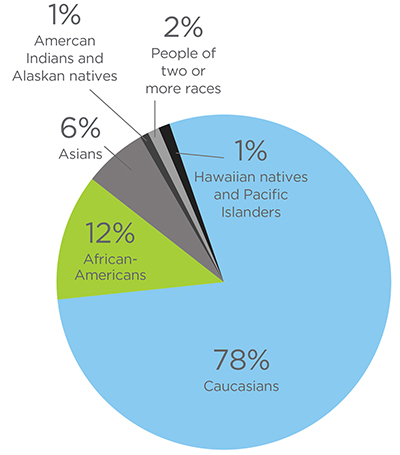Similar to many industries, the roofing industry is composed of different segments working together to fulfill a need. Roofing contractors, manufacturers, distributors, architects, consultants and other industry professionals play important roles in delivering quality roof systems to customers.
Likewise, the people employed by companies within these roofing industry segments must work together to help ensure the success of their companies. Whether employed as a field worker, manager, president, estimator, consultant, foreman, salesperson or something else, each individual brings his or her unique experiences and abilities—commonly influenced by race or ethnicity, gender and age—to his or her job.
Employers should be aware the individual differences within a diverse workforce can result in benefits such as increased connectivity with customers, enhanced problem-solving abilities and the ability to attract new workers.
Diversity in roofing
The most recent Bureau of Labor Statistics (BLS) data indicate there were more than 153 million workers (older than 15 years) of various ethnicities employed in the U.S. during 2017 (see Figure 1).
The figure notes 16.9 percent of the labor force was of Latino ethnicity. According to BLS, the term "Latino" "refers to persons who identified themselves in the enumeration process as being Spanish, Hispanic or Latino. Persons of Hispanic or Latino ethnicity may be of any race." A majority of Latinos in the labor force were Mexican. Women made up 46.9 percent of the U.S. labor force during 2017. And during 2016, there were about 21 million workers aged 16-24, 102 million workers aged 25-54, and 35 million workers aged 55 and older in the labor force.
Among all U.S. workers, 8 million were employed in construction and extraction occupations during 2017. Of those 8 million workers, 639,000 were employed as "first-line supervisors of construction trades and extraction workers" and 220,000 were employed as "roofers."

Source: Bureau of Labor Statistics There were more than 153 million workers of various ethnicities employed in the U.S. during 2017. |
A majority of first-line supervisors of construction trades and extraction workers were Caucasian; the percentage of Latino supervisors was only slightly higher than the percentage of Latino workers among all U.S. workers during 2017. However, more than half of roofing workers were Latino—a disproportionately high percentage.
Sherri Miles-Foley, president of Miles Roofing Inc., Chesapeake, Va., and vice president of J.D. Miles & Sons Inc., Chesapeake, says the number of Latino workers employed at Miles Roofing has increased during recent decades.
"Within our workforce, the number of Latino workers we employ has shifted from a minority to a majority," she says.
The Construction Chart Book—5th edition, compiled by The Center for Construction Research and Training in 2013 based on data collected by the U.S. Census Bureau, offers insight into the prevalence of Latino workers in the construction industry. During 2010, more than 40 percent of Latino construction workers reported they had entered the U.S. during the past decade, and 45 percent of the Latino immigrant workers reported they could not speak English well.
Immigrants settling in a new country require employment to support themselves. Unless the U.S. is experiencing an economic recession, the construction industry usually needs new workers to keep up with demand.
"We hire any able-bodied person who doesn't have a criminal background," says Timothy Blue, president of Blue's Roofing Co., Milpitas, Calif. "We can't afford to pass up anyone. More than 80 percent of our workforce is Latino—if we didn't have those workers, we wouldn't be getting our work done."
Among Latino immigrants, those who reported they did not speak English well may have sought employment in an industry that employs workers who speak the immigrants' native language. Having the ability to communicate with co-workers in a native language at a new job can help non-English speaking employees comprehend job training and bond with crew members.
Blue notes some Blue's Roofing workers have joined the company through their personal connections.
"Latino workers refer family and friends to bring them into the company and try to secure better-paying, steady work for them," Blue explains. "Latinos are attracted to the industry. Some other ethnic groups do not want to be in roofing because it's a hard, physically demanding job out in the sun. They don't want to do it."
According to The Construction Chart Book-5th edition, Latino construction workers generally were younger than non-Latino construction workers—the average age was 35 years for Latino workers compared with 44 years for non-Latino workers during 2010. Nearly one-third of Latino construction workers were younger than 30 years in 2010. Young people are strong and energetic enough to complete the physical labor required of field workers, and those who prove to be reliable workers may receive opportunities for future advancement within the industry.
The most noticeable difference between the U.S. labor force and the roofing industry's workforce is the low percentage of women working in the industry. Women comprised nearly half the U.S. labor force during 2017—BLS estimates about 939,000 women were employed in various occupation sectors of the construction industry, making up only 9.1 percent of the construction industry as of December 2016. Forty-five percent of female construction workers were employed in sales and office occupations, and 31 percent were employed in professional and management occupations. In the field, women made up only 3 percent of first-line supervisors of construction trades and extraction workers and only 0.6 percent of roofing workers during 2017.
The traditional view that jobs requiring physical labor are the domain of men has undoubtedly contributed to the low participation of women in the construction and roofing industries. Women who choose to join the construction industry may gravitate toward other industry segments. Among workers in construction and extraction occupations during 2017, women made up 6.6 percent of painters, 3.1 percent of insulation workers and 2.5 percent of electricians.
"Roofing is a physical job, and it's not the most high-paying job," Blue says. "If you're a woman looking for a job in the construction industry, you may make more money as an electrician or plumber and not have to do as much physical labor."
For some women who are in the industry, roofing is a family matter. Erica Jackson, president and co-owner of CYE Enterprises Inc., Jacksonville, Fla., comes from a family of roofing contractors.
"My grandfather was a roofer by trade, and my father was a roofer by trade who started his own company," she says. "I'm one of six children. My father thought his four boys would work in the roofing industry or construction, but none of them do. My sister and I work in the industry."
Miles-Foley's roofing career had a similar origin.
"My great-grandfather started J.D. Miles & Sons Roofing and Sheet Metal," she says. "My grandfather, my father and now my brother and I have continued working for the family companies."
Jennifer Ford-Smith, director of sales for Johns Manville Roofing Systems, Denver, began her career in a different industry before she started working at the roofing manufacturing company.
"I was previously in the window covering manufacturing industry," she explains. "A colleague of mine began working for Johns Manville and invited me to interview for a product manager position. The rest was history. I've been with Johns Manville for 16 years."
Jackson, Miles-Foley and Ford-Smith each have experienced challenges working in the male-dominated roofing industry. Before she owned her company, Jackson sometimes was asked by clients not to join the men during roof inspections because the clients believed it was not safe for a woman to go on a roof. Miles-Foley has had several experiences in which building owners, clients and salespeople assume she is not the person in charge of her company simply because she is female. But aside from these experiences, the women have received encouragement from industry men who realize women can have a place within it.
"I find the men in the industry as a whole have been amazing at fostering and developing women and pushing their careers along," Miles-Foley says. "I'm thankful for that. It's taken a lot of courage for men from the older generations to say to women, 'You guys can do this' and 'We need you.'"
Based on recent developments within CYE Enterprises, Jackson foresees a future in which more women join the roofing industry.
"We have experienced more growth in attracting female workers during the past three to four years," she explains. "It's never been a challenge to attract qualified females for office positions, but it has been a challenge in the past to attract experienced females for field work.
"Recently, we sourced for several positions including a safety director and field workers," Jackson continues. "I was pleased to see women as candidates, and some of the women were chosen for the positions based on their experience and knowledge. Those types of moments make me proud."
Benefits of diversity
BLS predicts the U.S. labor force will continue to diversify through at least 2026. Immigration will drive population growth, bringing an increase in the number of Latino and Asian workers. The women's labor force is expected to have a slightly higher annual growth rate than the men's labor force. In addition, the median age of the labor force is expected to rise slightly from 42.0 in 2016 to 42.3 in 2026—the highest level ever recorded.
These predictions indicate roofing industry employers will experience increased diversification within their companies in coming years as employers seek able-bodied workers to meet project demand, women increasingly join the industry and young workers are recruited to offset the retirement of older workers.
A diverse workforce can help companies connect with a variety of clients; provide an array of unique skills, perspectives and ideas; and help attract new workers.
Connecting with clients
To close sales, a company needs to establish relationships with customers. There are a multitude of sales tips and strategies that can be applied to accomplish this goal, but one factor employers may overlook is the benefit of having employees who can connect with a variety of clients.
Some customers may prefer to speak to an employee of the same race, ethnicity or gender as themselves. Others may feel most comfortable conducting business in a language other than English.
"We want to look like the faces of our clients," Miles-Foley says. "It's a great advantage to be able to represent all types of buyers, both residential and commercial."
In other cases, customers may appreciate more subtle connections. For example, during an interaction with homeowners who are deciding whether to repair or replace the roof system on their house for the first time, an employee with years of experience who can reassure the customers he or she has helped homeowners make this type of decision many times likely will help put the customers at ease. On the other hand, a younger homeowner making a similar decision may prefer to interact with a young, tech-savvy employee who can integrate the latest technology into his or her sales approach.
Jackson recognizes the importance of having younger employees who can help a company adopt new technology to improve efficiency and continue meeting customers' needs. At her company, she often is the one to initiate these changes.
"I am among the younger generation of roofing professionals," Jackson explains. "As a tech geek, I like to find ways we can make our jobs easier. My desire to stay up on the latest technology helps make CYE Enterprises more productive and efficient."
Having employees who can recognize and accommodate the implicit and explicit needs of a diverse clientele can only improve a company's bottom line. After all, happy customers often lead to referrals.
Unique contributions
Not every worker employed in the roofing industry will have the opportunity to interact with customers, but each individual brings valuable skills and unique perspectives to his or her position that can contribute to a company's success. According to construction labor solutions firm TradeSource, an employer with a diverse workforce has access to different perspectives and outlooks that can increase creativity and improve problem-solving. Bringing together industry professionals who have strong construction skills and diverse backgrounds provides a multifaceted approach to achieving project success by enabling the team to take advantage of each other's strengths.
"The advantages of a diverse workforce within our company have been the skills workers bring to their jobs," says Kelly Braddy Van Winkle, vice president—contracts for King of Texas Roofing Co. LP, Grand Prairie. "Each employee brings expertise and different skills. The more diverse our workforce is, the more skills we have represented among our employees."
Miles-Foley says her company also has benefited from the unique contributions made by its diverse group of employees.
"One great advantage of having a diverse workforce is that people bring their own experiences and perspectives to the workplace—either on the roof or in the office—and great ideas and energy come from that," she says. "We have looked at problems and issues differently and in a better way and have come to some decisions we wouldn't have if we didn't have diverse workers."
In addition to the practical and technical skills required for a job, employees likely also possess inherent skills that enhance their job performances.
For example, Braddy Van Winkle has observed the inherent skills female employees bring to their jobs.
"Building relationships with co-workers and customers is an essential component in our industry and something I believe women do well," she says. "Women also are great at handling day-to-day operations because they know how to direct people where to go and what to do to ensure work is being completed. I think responsibility and accountability are strengths among women."
But bringing together employees with different backgrounds and perspectives also can lead to challenges. Language barriers can prove problematic. If a new employee does not speak or understand English well, an employer may have to find alternate methods of communication, such as relying upon an established employee who speaks the language of the non-English speaker to communicate with him or her on the employer's behalf.
Employers also must contend with preconceived notions their employees may hold regarding people who are different than themselves. Such notions can lead to conflict between co-workers who may not understand or respect each other's actions, opinions or ideas.
"We have experienced some challenges related to diversity within our companies," Miles-Foley says. "It is difficult to view someone who looks different than you apart from the stereotypes you hold. It's a lot of learning how to get along and respect others, [and] working together can help establish respect."
Braddy Van Winkle's company takes measures to ensure its employees understand discrimination is not tolerated within the workplace.
"We have a written anti-discrimination policy in place," says Braddy Van Winkle. "In addition, we ask our foremen to make sure the workers they manage aren't excluding others, and we encourage them to emphasize teamwork among their teams."
Alex Hernandez, president of Clark Roofing Co., Broadview, Ill., employs a simple, effective tactic to bring his diverse employees together.
"Food is the universal equalizer," he explains. "Our staff often bring traditional dishes to share with co-workers."
Bringing employees together over a meal enables co-workers to connect with and learn about each other in a casual setting.
Attracting new workers
Employing a diverse group of individuals also may help employers attract new workers. A 2014 survey conducted by job and recruitment website Glassdoor found two-thirds of survey respondents indicated a diverse workforce is important when evaluating companies and job offers. The survey also revealed minority groups value diversity more than nonminority job seekers. Seventy-two percent of females surveyed indicated a diverse workforce is important to them, as well as 89 percent of African American respondents, 80 percent of Asian respondents and 70 percent of Latino respondents.
As the roofing industry currently is experiencing a labor shortage, contractor companies are competing to find qualified people to fill available positions. Employers should take advantage of every opportunity to present themselves as diverse and inclusive to attract applicants.
Looking ahead
When roofing industry employers contemplate future business goals, building a diverse workforce may not be a high priority. Often, more pressing concerns such as finding new ways to attract customers take precedence. However, employers should keep in mind the benefits a diverse workforce offers may help resolve a company's problems and advance its success.
As for how future diversification within the industry may occur, roofing professionals are optimistic the industry will continue to diversify naturally as companies hire the most qualified individuals for available positions.
"I expect anyone who wants to work within the industry will be considered, without predisposition, for any role they are qualified for," Hernandez says. "Upon hiring, new employees should be given an environment suitable for growth, improvement and learning."
Miles-Foley believes the industry is headed in the right direction.
"I hope we continue the current trajectory," Miles-Foley says. "I love that people within my company come from all backgrounds—there's a richness to that. I'm excited for the future of the roofing industry. I think we are better the more diverse we are because diversity can only elevate everyone."



